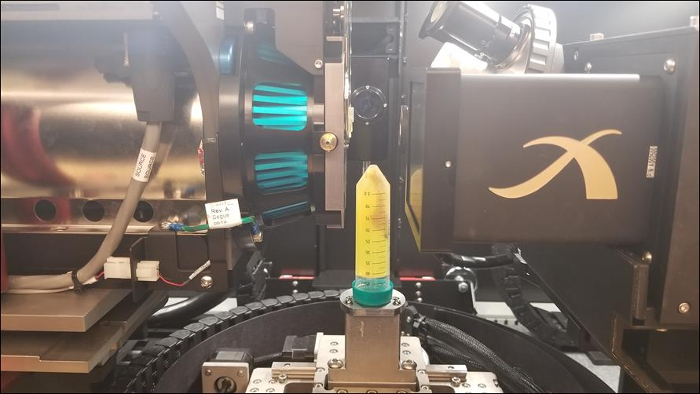Imagerie Micro-CT de la moelle épinière d'une souris
Source : Peiman Shahbeigi-Roodposhti et Sina Shahbazmohamadi, Département de génie biomédical, Université du Connecticut, Storrs, Connecticut
C'est un fait peu connu que la découverte et (par inadvertance) l'utilisation des rayons X a recueilli le premier prix Nobel de physique. La célèbre image aux rayons X de la main de la femme du Dr Ràntgen de 1895 qui a envoyé des ondes de choc à travers la communauté scientifique ressemble à la plupart des images 2D 2D de radiographie médicale moderne. Bien qu'il ne s'agit pas de la technologie la plus récente, l'imagerie par absorption des rayons X est un outil indispensable et se trouve dans les meilleurs laboratoires de R-D et d'université au monde, dans les hôpitaux, les aéroports, entre autres. On peut soutenir que les utilisations les plus avancées de l'imagerie par absorption des rayons X impliquent d'obtenir des informations comme celles trouvées dans une radiographie médicale 2D, mais réalisées en 3D grâce à une tomographie calculée (CT ou micro-CT). En prenant une série de projections de rayons X 2D, un logiciel avancé est capable de reconstruire des données pour former un volume 3D. Les informations 3D peuvent, et très probablement comprendra des informations de l'intérieur de l'objet sondé sans avoir à être coupé ouvert. Ici, une micro-CT scan sera obtenue, et les principaux facteurs ayant une incidence sur la qualité de l'image seront discutés.
1. Montage d'un échantillon (Os)
- Pour examiner un réseau d'os, comme une colonne vertébrale, suspendez la structure dans un gel d'agarose et laissez guérir dans un tube en plastique à parois très minces (figure 2). La minceur du tube est très importante, affectant considérablement le débit du signal et la qualité globale de l'image. Cela affecte à son tour votre capacité à résoudre les fonctionnalités. La valeur de transmission du tube doit être aussi proche de 100% que possible.
- Montez le tube sur l'
Les images suivantes donnent un aperçu des résultats qui peuvent être obtenus à partir de l'utilisation de micro-CT avec la procédure indiquée ci-dessus. Des mesures qualitatives sur l'absorption variable peuvent être directement notées sur la base de ces images. Les données quantitatives telles que la porosité matérielle, la taille et la distribution des fonctionnalités, etc. nécessiteraient un traitement d'image supplémentaire dans un logiciel différent.
Log in or to access full content. Learn more about your institution’s access to JoVE content here
Cette expérience a examiné les nombreux facteurs qui devraient être pris en considération lors de l'utilisation de micro-CT, en particulier pour un échantillon biologique. Ce projet a été conçu pour aider l'enquêteur à comprendre comment ses décisions auront une incidence sur les données que le micro-CT peut fournir. Comme nous l'avons démontré, il existe de nombreux paramètres dépendants et sensibles qui devraient être pris en considération, notamment : montage, énergie des rayons X, temps d'expositio...
- http://www.spectroscopyonline.com/tutorial-attenuation-X-rays-matter [cited 1 November 2017]
- http://hyperphysics.phy-astr.gsu.edu/hbase/quantum/xrayc.html [cited 1 November 2017]
- A.G. Rao, V.P. Deshmukh, L. L. Lavery, H. Bale, "3D investigation of the microstructural modification in hypereutetic aluminum silicon (Al-30Si) alloy." Microscopy and Analysis 2017 [cited 1 November 2017].
Passer à...
Vidéos de cette collection:

Now Playing
Imagerie Micro-CT de la moelle épinière d'une souris
Biomedical Engineering
7.9K Vues

Imagerie d'échantillons biologiques par microscopie optique et confocale
Biomedical Engineering
35.6K Vues

Imagerie d'échantillons biologiques par MEB
Biomedical Engineering
23.5K Vues

Biodistribution des nanomédicaments : Application de la microscopie à balayage électronique
Biomedical Engineering
9.3K Vues

Imagerie par ultrasons à haute fréquence de l'aorte abdominale
Biomedical Engineering
14.4K Vues

Cartographie quantitative de la déformation d'un anévrisme de l'aorte abdominale
Biomedical Engineering
4.6K Vues

Tomographie photoacoustique pour l'imagerie du sang et des lipides dans l'aorte infrarénale
Biomedical Engineering
5.7K Vues

Imagerie par résonance magnétique cardiaque
Biomedical Engineering
14.6K Vues

Simulations numériques de la dynamique des fluides du flux sanguin lors d'un anévrisme cérébral
Biomedical Engineering
11.7K Vues

Imagerie des anévrismes de l'aorte abdominale par fluorescence dans le proche infrarouge
Biomedical Engineering
8.2K Vues

Techniques de mesure non invasive de la pression artérielle
Biomedical Engineering
11.8K Vues

Acquisition et analyse d'un signal ECG (électrocardiographie)
Biomedical Engineering
104.2K Vues

Résistance à la traction des biomatériaux résorbables
Biomedical Engineering
7.5K Vues

Visualisation de la dégénérescence de l'articulation du genou après une blessure non invasive du LCA chez le rat
Biomedical Engineering
8.2K Vues

Imagerie combinée SPECT et CT pour visualiser la fonctionnalité cardiaque
Biomedical Engineering
11.0K Vues
